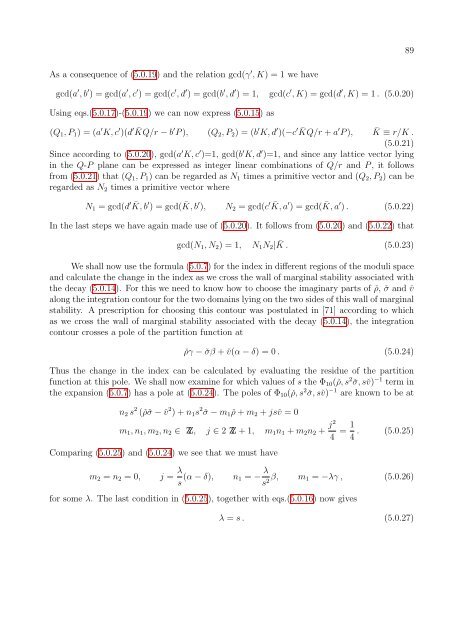PHYS08200604018 Shamik Banerjee - Homi Bhabha National ...
PHYS08200604018 Shamik Banerjee - Homi Bhabha National ...
PHYS08200604018 Shamik Banerjee - Homi Bhabha National ...
You also want an ePaper? Increase the reach of your titles
YUMPU automatically turns print PDFs into web optimized ePapers that Google loves.
89<br />
As a consequence of (5.0.19) and the relation gcd(γ ′ , K) = 1 we have<br />
gcd(a ′ , b ′ ) = gcd(a ′ , c ′ ) = gcd(c ′ , d ′ ) = gcd(b ′ , d ′ ) = 1, gcd(c ′ , K) = gcd(d ′ , K) = 1 . (5.0.20)<br />
Using eqs.(5.0.17)-(5.0.19) we can now express (5.0.15) as<br />
(Q 1 , P 1 ) = (a ′ K, c ′ )(d ′ ¯KQ/r − b ′ P ), (Q 2 , P 2 ) = (b ′ K, d ′ )(−c ′ ¯KQ/r + a ′ P ), ¯K ≡ r/K .<br />
(5.0.21)<br />
Since according to (5.0.20), gcd(a ′ K, c ′ )=1, gcd(b ′ K, d ′ )=1, and since any lattice vector lying<br />
in the Q-P plane can be expressed as integer linear combinations of Q/r and P , it follows<br />
from (5.0.21) that (Q 1 , P 1 ) can be regarded as N 1 times a primitive vector and (Q 2 , P 2 ) can be<br />
regarded as N 2 times a primitive vector where<br />
N 1 = gcd(d ′ ¯K, b ′ ) = gcd( ¯K, b ′ ), N 2 = gcd(c ′ ¯K, a ′ ) = gcd( ¯K, a ′ ) . (5.0.22)<br />
In the last steps we have again made use of (5.0.20). It follows from (5.0.20) and (5.0.22) that<br />
gcd(N 1 , N 2 ) = 1, N 1 N 2 | ¯K . (5.0.23)<br />
We shall now use the formula (5.0.7) for the index in different regions of the moduli space<br />
and calculate the change in the index as we cross the wall of marginal stability associated with<br />
the decay (5.0.14). For this we need to know how to choose the imaginary parts of ˇρ, ˇσ and ˇv<br />
along the integration contour for the two domains lying on the two sides of this wall of marginal<br />
stability. A prescription for choosing this contour was postulated in [71] according to which<br />
as we cross the wall of marginal stability associated with the decay (5.0.14), the integration<br />
contour crosses a pole of the partition function at<br />
ˇργ − ˇσβ + ˇv(α − δ) = 0 . (5.0.24)<br />
Thus the change in the index can be calculated by evaluating the residue of the partition<br />
function at this pole. We shall now examine for which values of s the Φ 10 (ˇρ, s 2ˇσ, sˇv) −1 term in<br />
the expansion (5.0.7) has a pole at (5.0.24). The poles of Φ 10 (ˇρ, s 2ˇσ, sˇv) −1 are known to be at<br />
n 2 s 2 (ˇρˇσ − ˇv 2 ) + n 1 s 2ˇσ − m 1 ˇρ + m 2 + jsˇv = 0<br />
m 1 , n 1 , m 2 , n 2 ∈ Z, j ∈ 2 Z + 1, m 1 n 1 + m 2 n 2 + j2<br />
4 = 1 4 . (5.0.25)<br />
Comparing (5.0.25) and (5.0.24) we see that we must have<br />
m 2 = n 2 = 0, j = λ s (α − δ), n 1 = − λ s 2 β, m 1 = −λγ , (5.0.26)<br />
for some λ. The last condition in (5.0.25), together with eqs.(5.0.16) now gives<br />
λ = s . (5.0.27)

















